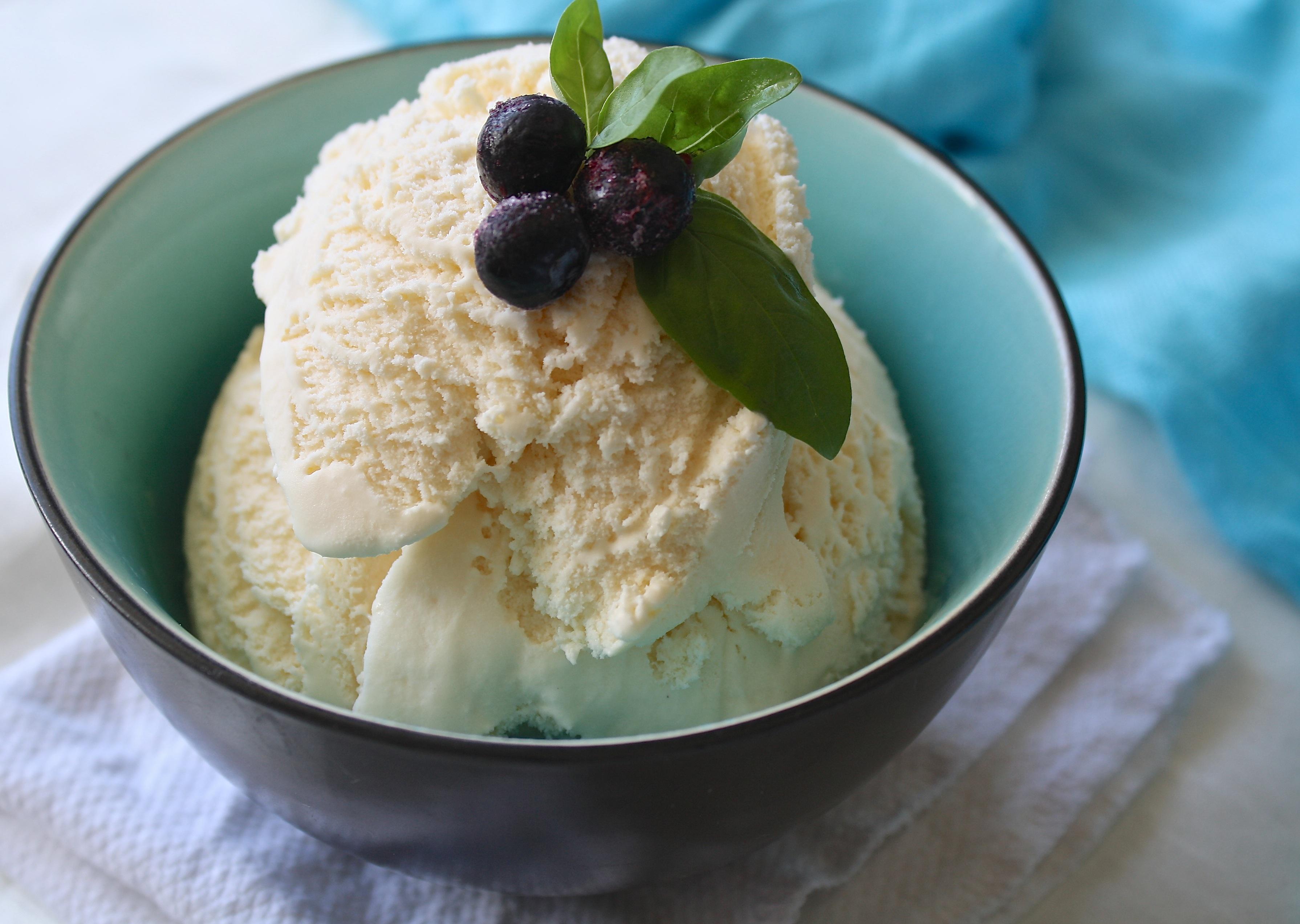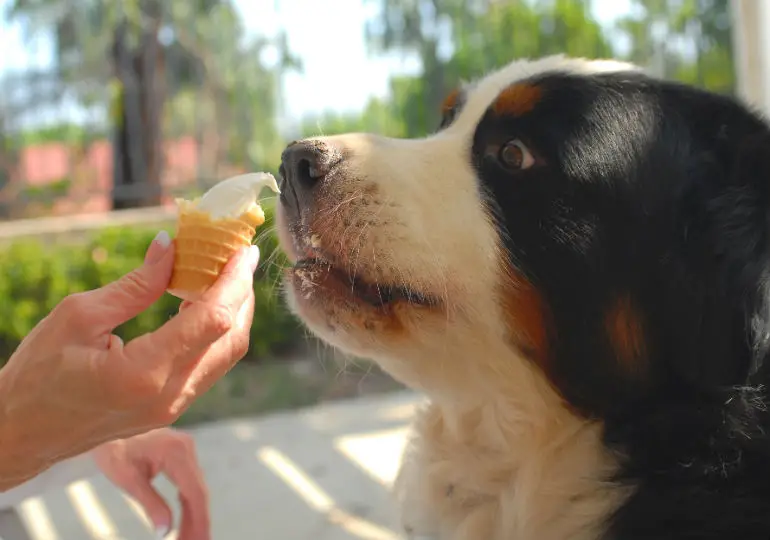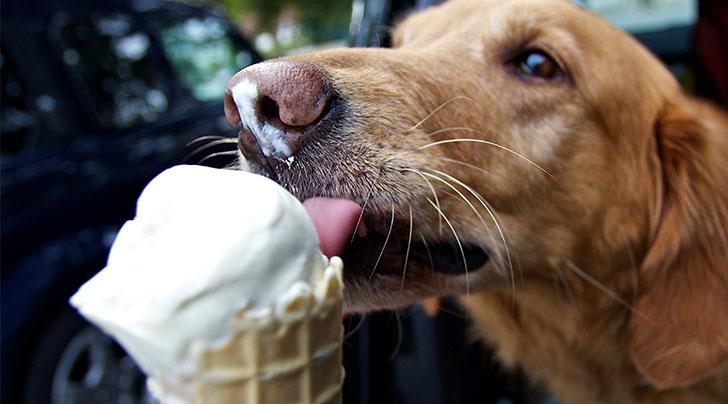Table of Contents
Can Dogs Have Vanilla Ice Cream? All You Need To Find Out And More…
Can dogs have vanilla ice cream? We all know that ice cream is delicious, and you want to share all the good things in your life with your dog.
However, before allowing your dog to lick your cone, you should consider if it is safe for them to do so. After all, you don’t want to rush your dog to the emergency clinic because you gave your dog a taste of vanilla ice cream.
So, to set your mind at ease, we looked into the study to see if it is ok to give your dog a taste of your frozen treat-because there’s nothing cuter than a dog licking your ice cream cone.
Let’s find out can dogs have vanilla ice cream or not. If not, what could be the reason?
Can dogs have vanilla ice cream?

There are two questions here, one of which you already know the answer to.
The answer to the first question, “Is it safe?” is probably yes, because there’s nothing harmful in vanilla ice cream that would kill your dog if it tasted. Unless your dog is lactose intolerant, a small amount of ice cream is unlikely to harm them.
One major caveat here: Some ice creams contain artificial sweeteners, mainly those with reduced sugar content. Some sweeteners, such as Xylitol, are harmful to dogs and can kill them, so read the label before handing your mutt a spoon.
Now, there’s a second question: Should you feed your dog vanilla ice cream? You already know the answer to this. Even though you shouldn’t eat it yourself, you shouldn’t give it to your dog.
We understand it’s tempting to give your dog ice cream because we’ve done the same thing in the past. Still, that doesn’t make it a good idea.
Reasons why Vanilla Ice Cream is Bad for Dogs?
Dogs shouldn’t eat ice cream for the following reasons:
1. Lactose Intolerance
After weaning, puppies’ bodies produce less lactase, making them less efficient at breaking down milk proteins. Many adult dogs, like people, are lactose intolerant to varying degrees. It makes them difficult to digest milk products.
Dairy products can cause mild to severe gastrointestinal discomfort in lactose-intolerant dogs, including loose stools, itchy skin rashes, soreness, diarrhea, vomiting, and gas. High-fat milk products such as cream and ice cream also cause Pancreatitis.
2. Obesity and Diabetes
You may not have realized that your dog might suffer from the same illnesses as humans, such as obesity and diabetes. Ice cream has high sugar and fat content, making it unhealthy.
Osteoarthritis, skin allergies, blood pressure problems, and heart disease are all potential side effects of eating too many high-fat, high-sugar foods. Even sugar-free ice cream can be hazardous to your dog’s health. We’ll find out why in the following section.
3. Xylitol Poisoning
Xylitol is a sugar substitute commonly used in sugar-free sweets and candy. However, Xylitol is harmful to dogs, so choosing a sugar-free ice cream to share with your dog may cause more harm than good. Before giving your sugar-free dog goods, always examine the ingredients.
4. Toxic Flavors
Although some fruit-flavored sorbets, such as mango, are safe for dogs to eat on occasion, most ice cream varieties are not.
Chocolate includes theobromine and caffeine, which are hazardous to dogs since they cannot digest these components properly.
Caffeine in coffee ice cream is also harmful. Macadamia nuts, for example, are toxic to dogs, and raisins can also be dangerous.
Why Is Xylitol Toxic To Dogs?

Xylitol is a natural alcohol that comes from plants and has a sweet taste. Even though it’s safe for people to eat, even small amounts can make your dog sick or even kill them.
The difference is that Xylitol is quickly absorbed into a dog’s bloodstream when eaten. This makes the pancreas release insulin fast, and in as little as ten minutes, the blood sugar drops to a dangerous level. When taken in large amounts, xylitol can lead to liver failure.
Call your vet or the Pet Poison Helpline right away if you think your dog might have eaten Xylitol in toothpaste, peanut butter, and gum.
Symptoms to Look For Xylitol Poisoning in Your Dog:
Xylitol poisoning symptoms in dogs after eating human foods such as vanilla ice cream:
- Vomiting
- Decreased physical activity
- Weakness
- Staggering
- Incoordination
- Collapse
- Seizures.
What If Your Dog Accidentally Ate Ice Cream?
Don’t worry if you dropped your frozen treat and your dog licked it all up before you could clean it up. Your dog should be fine if it were just a small amount of vanilla ice cream.
On the other hand, call your vet if your pet ate any toxic flavors like macadamia, Xylitol, or even chocolate. In the worst cases, you should take your dog to the nearest clinic to keep the poison from getting into his body.
Are There Any Health Benefits to Giving Your Dog Vanilla Ice Cream?
Not really. There are a few nutrients in ice cream (like calcium). Still, they don’t exist in sufficient quantities to counterbalance all the junk.
Of course, your dog would likely argue that there are mental health benefits to eating ice cream, but we can’t speak to that.
Can dogs have vanilla ice cream if they are Lactose-Intolerant?

Lactose-intolerant dogs should never consume vanilla ice cream or any other dairy products. If you’re unsure if they can handle lactose, give them a tablespoon of a healthy option like probiotic-rich plain yogurt. If they don’t show signs of gastrointestinal trouble within the next 12 to 24 hours, you can give them a slightly larger piece and watch their reaction.
Suppose they can eat a small amount of plain yogurt without getting too much gas, bloating, throwing up, or having diarrhea. In that case, they may be able to eat a spoonful or two of vanilla ice cream on rare occasions.
Can dogs have vanilla ice cream or other flavors?
Dogs can sometimes have minimal amounts of a few different kinds of ice cream. But if you want to give your dog the last bite of your ice cream, make sure that what you’re eating is safe for dogs.
Even though many fruit and peanut butter flavors are safe, you should never give your dog ice cream with chocolate, cocoa powder, or nutmeg. These are harmful to dogs and can cause severe vomiting and diarrhea or even death in the worst cases.
Safe ice cream doesn’t have to be low in calories or fat, but it can’t be either. Even if dogs like the taste of low-calorie and low-fat ice creams that contain artificial sweeteners like Xylitol, they shouldn’t eat them.
Alternatives to vanilla ice cream
If your dog likes ice cream, it can be hard to get them to stop wanting it. If you don’t want a dog to beg for ice cream the next time you’re eating a cone, you might want to look into alternatives.
Ice cream made with dog-friendly ingredients
On a hot day, sweet, frozen treats can perk up just about anyone. Dogs eat ice cream for many of the same reasons: to cool down and satisfy their sweet tooth.
Giving them ice cream made just for dogs is a great way to let them do this without putting them in danger by giving them human ice cream.
Pet ice cream shops and snack shops are a growing niche gaining popularity recently. Because most pets have developed a taste for this stuff during the pandemic, they are still pretty rare, but if you live near one, you can give your dog ice cream without worrying about it getting sick.
Frozen fruit
Fruits are much better for dogs than any other kind of sweet food. When you mix certain frozen fruit, it can taste like ice cream. This is especially true for fruits with soft flesh, like dragon fruit. Yes! Blended frozen bananas are also a great way to make your dog feel like he is eating ice cream without giving him any. Add some crushed ice to a blender or food processor to make it feel more relaxed.
If your dog loves the smell and taste of vanilla, look for vanilla extract without alcohol and add it to the mix.
Frozen yogurt
Most commercial frozen yogurt is better for dogs than ice cream because it helps them digest and has probiotic properties. It also has much less sugar, and there is no chance of getting sick from Xylitol. Remember that frozen yogurt still has milk in it, so dogs that can’t handle lactose shouldn’t eat it. Look for frozen yogurt that your dog can dine at a store that sells treats for pets. If you want to avoid harmful ingredients as much as possible, get plain yogurt without added sugar.
Other kinds of ice cream

While there isn’t much that makes vanilla ice cream excellent for dogs, it is one of the safest flavors to eat among the many available. Most ice cream flavors, such as chocolate and coffee, contain caffeine, which causes dangerously high blood pressure, cardiac difficulties, and digestive problems in dogs. The low-fat vanilla flavor usually is fine for kids to eat on occasion. However, it is still preferable to find an alternative.
Fruit-flavored sorbets are usually the best bet because they rarely include dairy. However, because they are still highly sweet, they should be limited to an occasional snack. However, you can serve them to your dog without danger of poisoning unless the fruit used in the sorbet is hazardous to dogs. However, always check the label to verify if your product contains Xylitol or lactose.
Sugar-free ice cream is not advised because it is typically sweetened with other artificial substances that are even more dangerous to dogs. Xylitol is frequently still included in these products.
Vegan ice cream is a horrible idea as well. While these ice creams are dairy-free, the smoothness is typically derived from macadamia nuts, almonds, or other nuts that can irritate dogs’ stomachs, if not poison them.
Final words: Can dogs have vanilla ice cream?
Although a sip of spilled vanilla ice cream will not damage your dog, there are many reasons not to give your dog ice cream, and some others are not to swallow, even accidentally.
Make your animal best friend some frozen blended banana treats. Add some peanut butter to the mix for a more gourmet touch if you want him to share in your summer munchies.
It is critical always to verify the contents and, preferably, only serve your dog food and treats specifically created for dogs.
Can dogs have vanilla ice cream and more FAQs?
1. Is vanilla flavoring toxic to dogs?
Vanilla extract or imitation vanilla includes a high concentration of alcohol, which is hazardous to dogs. They are unable to degrade alcohol, posing a risk of alcohol poisoning. Your dog will be fine with alcohol-free vanilla that contains vegetable glycerin instead.
2. Can a dog eat vanilla yogurt?
Because yogurt is fermented and has less lactose, it is easier for dogs to digest. Hence, it is a far superior option to ice cream. On the other hand, commercial frozen yogurt should be avoided because it includes far more sugar. Although yogurt is easy for dogs to digest than other dairy products, it is not suitable for all dogs. Test a small amount first, and always keep the servings small as an occasional treat only.
3. Can I give my dog vanilla ice cream from Mcdonald’s?
McDonald’s assured the public that its vanilla ice cream contains no xylitol and poses no immediate poisoning risk [3]. However, their ice cream still contains dairy and a lot of sugar. Not to mention that vanilla always poses the risk of alcohol poisoning in dogs. While many pet owners have got away with feeding “pup cups” to their dogs, it is ideal if you only give them a few little amounts at a time.
4. Is Vanilla Dairy Queen Ice Cream safe for my dog?
Dairy Queen’s hidden dog menu includes a pup cup with a soft serve that is safe for dogs to eat. The secret menu is specifically intended for dogs, lowering the risks of eating their ice cream. To be safe, while there are various flavors to pick from, you should stay with basic vanilla or a fruit sorbet option.
4. What type Of Vanilla Ice Cream Can Dogs Have?
You should only give your dog ice cream without chocolate or Xylitol, macadamia nuts, or coffee beans if you are a dog owner. If it appears you shouldn’t select vanilla, vanilla – or any other low-fat vanilla – is better. A homemade frozen treat made from ingredients dog-safe can also be considered an alternative to ice cream in place of dog ice cream.
6. What should I do if my dog has an upset stomach?
If your dog gets a small stomach problem, you might be able to treat it yourself. Feed your dog plain boiled chicken with plain cooked rice in modest amounts throughout the day. Stick to this diet for a few days before returning to his regular feeding regimen by gradually introducing small portions of his regular food into the mix. You might also fast your dog for a day to allow his stomach to empty of the toxins included in vanilla ice cream.
Most importantly, your dog should always have access to plenty of fresh, clean water. Contact a veterinarian immediately if you notice significant signs like dehydration or lethargy, pain, a hard enlarged stomach, or blood in vomit or feces.
That was everything about- Can dogs have vanilla ice cream or not.


